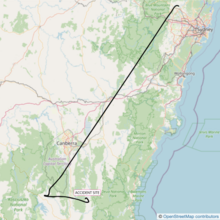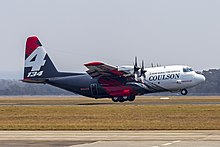|
2020 Coulson Aviation Lockheed C-130 Hercules crash
On 23 January 2020, a Lockheed EC-130Q Hercules, owned by Coulson Aviation, crashed while aerial firefighting for the New South Wales Rural Fire Service during Australia's black summer bushfires. All three crew on board the flight were fatally injured when the aircraft hit a tree before colliding with the ground, followed by a post-impact fuel-fed fire. The victims were US residents who were in Australia to help fight numerous substantial bushfires in the region. The Australian Transport Safety Bureau (ATSB) determined the cause of the collision was likely due to the dangerous weather conditions, low-level wind shear and an increased tailwind, leading to the aircraft stalling while releasing fire retardant foam at a low height and airspeed and colliding with terrain. BackgroundAustralia's black summer bushfires of 2019 and 2020 saw over 2000 homes destroyed, 24.3 million hectares (60 million acres) of land burnt, and 34 deaths on Australia's east coast.[2] As part of the firefighting efforts, many small and large aircraft were used for both aerial firefighting and to provide emergency services with information on the bushfire's activities.[3] On 23 January 2020, at around 11 a.m., the New South Wales (NSW) Rural Fire Service (RFS) State Operations Centre tasked two air tankers and an observation aircraft from RAAF Base Richmond to the Adaminaby Fire-ground due to the escalating fire danger to the Adaminaby township and rural properties being under threat from a spreading fire paired with strong winds, severe fire weather conditions.[4] Aircraft historyThe aircraft, an EC-130Q Hercules, registered N134CG, was operated by Coulson Aviation (Australia) Pty Ltd and manufactured by the Lockheed Corporation in 1981. It was powered by four Allison T56-A-15 turboprop engines. The aircraft was previously owned by the US Navy who transferred it to NASA in 1992, who later placed it in storage. The aircraft was then retrofitted in 2018 by Coulson Aviation for the purpose of aerial firefighting and had a 4,000-U.S.-gallon (15,000 L) firefighting tank system installed. The aircraft had a total time-in-service of 11,888 hours, 683 of which were spent firefighting since its conversion in 2018.[5] The aircraft was in Australia because of a seasonal agreement the NSW RFS had with Canada's Coulson Aviation ahead of Australia's bushfire season.[6] TimelineBomber 137Of the two air tankers, Bomber 137 (B137), a Boeing 737 aircraft, registered N137CG, departed the base at 11:27 am and arrived at the Adaminaby Fire-ground at around 11:55 am. The crew circled the planned drop area for around 25 minutes due to the weather conditions and because of ground-based firefighters in the planned drop area. During the flight, the B137 crew encountered a wind shear warning on the aircraft's computer system and strong winds causing uncontrolled banking of up to 45º. The B137 crew reported 50-knot (93 km/h) winds at 800 feet (240 m) above ground level and 37-knot (69 km/h) winds at 200 feet (61 m) above ground level. Having successfully deployed the fire retardant load, the B137 aircraft left the fire-ground at around 12:25 pm with the pilot-in-command (PIC) advising cancellation of aircraft operation in the area due to the "horrible" weather conditions. The B137 crew then received a request to reload the aircraft with fire retardant in Canberra and return to Adaminaby Fire-ground. The PIC replied that they would not be returning to the fire-ground as the "winds were getting too strong and the visibility is [low]."[7] Bomber 134 The second air tanker, Bomber 134 (B134), a Lockheed EC-130Q Hercules, registered N134CG, carrying three crew on board,[1] departed the base at around 12:05 pm. At around 12:35 pm, while en route to the fire-ground, the PIC of B137 contacted the PIC of B134 informing them that due to the extreme winds, they would not be returning to the fire-ground. During this exchange, the PIC of B134 asked the PIC of B137 several questions about the conditions. With this information, the crew decided that they would continue to assess the conditions themselves.[8] After arriving at the Adaminaby Fire-ground at around 12:51 pm the B134 crew made several orbits around the fire-ground at a height of around 2,000 feet (610 m) AGL and decided that the conditions were too unsafe for a retardant drop at the fire-ground. At around 12:55 pm, the crew informed the Cooma Fire Control Centre of their decision.[9] The Cooma Fire Control Centre then provided the crew with the location of a fire in Good Good, about 58 km (36 mi) to the east of Adaminaby. The Fire Control Centre requested the B134 crew look for targets of opportunity in the interest of protecting structures and property near Peak View. At around 12:59 pm, the B134 crew informed air traffic control of their new coordinates at the Good Good Fire-ground. At around 1:07 pm, the aircraft arrived at the drop area and after completing two orbits of the drop area, the B134 crew advised the Fire Control Centre that they were prepared to go ahead with the drop. At 1:15:15 pm, the crew completed a partial retardant drop at around 190 feet (58 m) AGL releasing about 1,200 U.S. gallons (4,500 L) of fire retardant. The aircraft then began climbing to around 330 feet (100 m) AGL where it began to rock from around an 18º left angle of bank to then a 6º right angle of bank. At 1:15:32 pm, the aircraft started descending to a very low height above the ground with a left roll. At around 1:15:37 pm, the aircraft collided with the ground and a post-impact fuel-fed fire ensued. All three crew were fatally injured and the aircraft was destroyed. No distress calls were received by air traffic control prior to the impact.[10] VictimsAll three victims were US residents who were working in Australia to assist during the black summer bushfires.[6] Ian McBeth, the pilot-in-command, lived in Montana and served as a pilot in the United States Wyoming Air National Guard and Montana Air National Guard working in the area of aerial firefighting. McBeth, who was flying his final shift at the time of the accident, worked for Coulson Aviation since 2014.[11][12][13] McBeth had a total flying experience of 4,010 hours, 3,010 of which were in the C-130 aircraft. He had also completed 994 air tanker drops over his career.[14] Paul Hudson, the copilot, served in the US Marine Corps for 20 years before his retirement as lieutenant colonel in 2019.[11][15] Hudson, who joined Coulson Aviation in September 2019, had a total flying experience of 1,744 hours, of which about 1,364 hours were on the C-130 aircraft. It was Hudson's first fire season, when he flew to Australia on 1 December 2019 and in that time had flown around 85 hours.[16] Rick DeMorgan, the flight engineer, served in the US Air Force for 24 years and completed thirteen deployments to Iraq and Afghanistan.[11][17] DeMorgan, who joined Coulson Aviation in November 2019 and was flying his first fire season, had experience of 4,050 hours on the C-130 aircraft as a flight engineer.[16] Investigation The ATSB investigation's final report detailing the occurrence, findings, and safety recommendations was released on 29 August 2022.[18] The accident site was located near Peak View, New South Wales, with the debris trail distributed linearly over around 180 m of terrain. The on-site examination found that the aircraft collided with a tree before colliding with the ground. An intense post-impact fuel-fed fire destroyed the aircraft. There was no evidence of pre-impact structural damage.[19]  The aircraft's cockpit voice recorder did not record the accident flight, when the data what downloaded, the ATSB found thirty-one minutes of audio data from a flight in the previous year. It was likely that an inertial switch in the unit was activated during a previous landing of the aircraft and consequently disconnected power to the device.[20] CauseThe ATSB's investigation identified the following to be factors contributing to the aircraft's collision:[21]
The ATSB's investigation also identified the following to be factors that increased risk levels associated with the flight:[21]
Findings and recommendations The ATSB highlighted a number of safety issues and issued a number of recommendations in its final report. The ATSB found that:[22]
AftermathFollowing the aircraft accident and the ATSB investigation, Coulson Aviation have incorporated a windshear recovery procedure into their C-130 Airplane Flight Manuals and simulator-based, recurrent windshear training. They have also implemented a pre-flight risk assessment to be completed by the pilot in command prior to the first tasking of the day. They will also be introducing a three-tier risk management approach, of organisational risk, operational risk, and tactical/mission risk, to be utilised during the upcoming fire season in Australia. Further, Coulson Aviation have updated their pre-flight procedures to incorporate a cockpit voice recorder system check before each flight.[23] The NSW RFS, in response to the accident, have commissioned an independent report into the management of airspace in which aircraft are operating in support of fire-fighting activities, formalised and establish a 'Large Air Tanker Co-ordinator' role description, to be positioned on the State Air Desk during heightened fire activity, and have undertaken an audit, in conjunction with operators, of pilots qualified as initial attack capable and ensure appropriate records are accessible by RFS personnel. Further, they have undertaken detailed research to identify best practice (nationally and internationally) relating to task rejection and aerial supervision policies and procedures as well as initial attack training and certification. They have also undertaken a comprehensive review of NSW RFS aviation doctrine to incorporate lessons from this incident into their existing policies and procedures.[23] Following the death of pilot-in-command, Ian McBeth, his family established a foundation called the Ian McBeth Foundation. It supports the Montana National Guard, the Wyoming National Guard, and the Wray, Colorado, community, which were important organisations to McBeth.[12] In popular cultureThe accident will be featured in season 25 of the Canadian documentary series Mayday, titled "Firebomber Down".[24] See alsoReferences
Sources
External linksWikimedia Commons has media related to N134CG (aircraft).
|
||||||||||||||||||||||||||||||||||
Portal di Ensiklopedia Dunia
